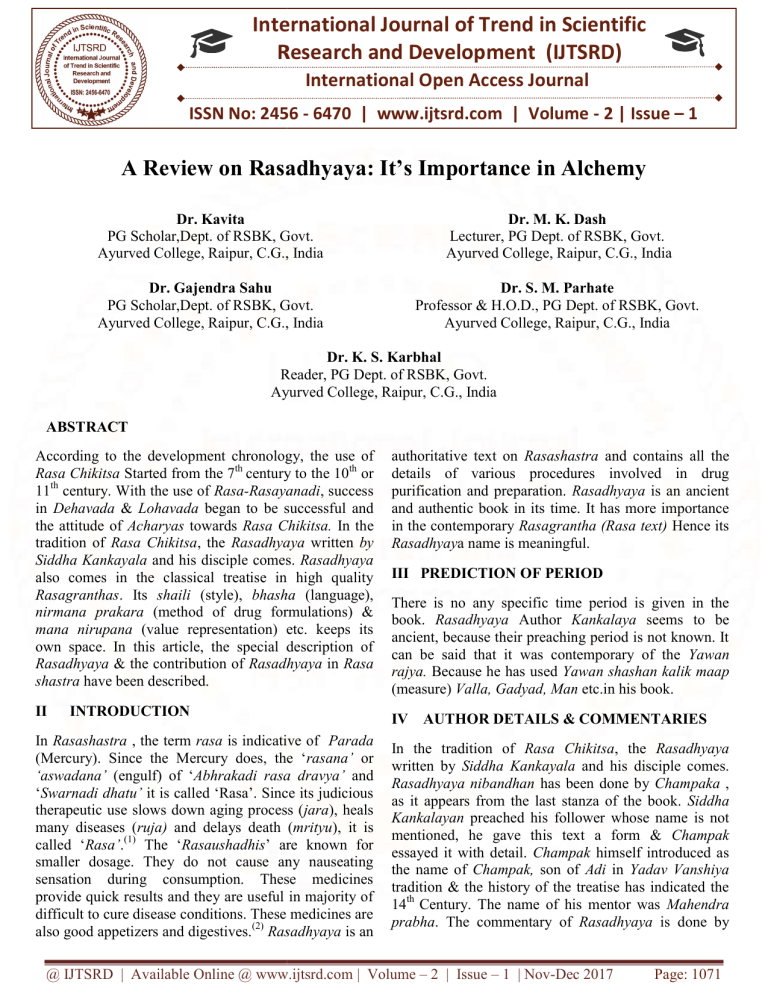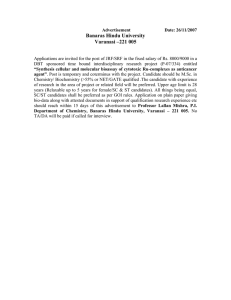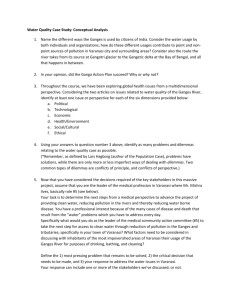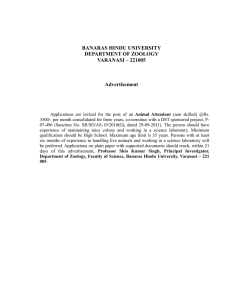
International Journal of Trend in Scientific Research and Development (IJTSRD) International Open Access Journal ISSN No: 2456 - 6470 | www.ijtsrd.com | Volume - 2 | Issue – 1 A Review on n Rasadhyaya: It’s Importance in n Alchemy Dr. Kavita PG Scholar,Dept. of RSBK, Govt. Ayurved College, Raipur, C.G., India Dr. M. K. Dash Lecturer, PG Dept. of RSBK, Govt. Ayurved College, Raipur, C.G., India Dr. Gajendra Sahu PG Scholar,Dept. of RSBK, Govt. Ayurved College, Raipur, C.G., India Dr. S. M. Parhate Professor & H.O.D., PG Dept. of RSBK, Govt. Ayurved College, Raipur, C.G., India Dr. K. S. Karbhal Reader, PG Dept. of RSBK, Govt. Ayurved College, Raipur, C.G., India ABSTRACT According to the development chronology, the use of Rasa Chikitsa Started from the 7th century to the 10th or 11th century. With the use of Rasa-Rasayanadi Rasayanadi, success in Dehavada & Lohavada began to be successful and the attitude of Acharyas towards Rasa Chikitsa. In the tradition of Rasa Chikitsa, the Rasadhyaya written by Siddha Kankayala and his disciple comes. Rasadhyaya also comes in the classical treatise in high quality Rasagranthas. Its shaili (style), bhasha (language), nirmana prakara (method of drug formulations) & mana nirupana (value representation) etc. keeps its own space. In this article, the special description of Rasadhyaya & the contribution of Rasadhyaya in Rasa shastra have been described. II INTRODUCTION In Rasashastra , the term rasa is indicative of Parada (Mercury). Since the Mercury does, the ‘‘rasana’ or ‘aswadana’ (engulf) of ‘Abhrakadi Abhrakadi rasa dravya’ and ‘Swarnadi dhatu’ it is called ‘Rasa’. Since its judicious therapeutic use slows down aging process ((jara), heals many diseases (ruja) and delays death ((mrityu), it is called ‘Rasa’.(1) The ‘Rasaushadhis’’ are known for smaller dosage. They do not cause any nauseating sensation during consumption. These medicines provide quick results and they are useful in majority of difficult to cure disease conditions. These medicines are also good appetizers and digestives.(2) Rasadhyaya is an authoritative text on Rasashastra and contains all the details of various procedures involved in drug purification and preparation. Rasadhyaya is an ancient and authentic book in its time. It has more importance in the contemporary Rasagrantha (Rasa text) Hence its Rasadhyayaa name is meaningful. III PREDICTION OF PERIOD There is no any specific time period is given in the book. Rasadhyaya Author Kankalaya seems to be ancient, because their preaching period is not known. It can be said that it was contemporary of the Yawan rajya. Because he has used Yawan shashan kalik maap (measure) Valla, Gadyad, Man etc.in his book. IV AUTHOR THOR DETAILS & COMMENTARIES In the tradition of Rasa Chikitsa, Chikitsa the Rasadhyaya written by Siddha Kankayala and his disciple comes. Rasadhyaya nibandhan has been done by Champaka , as it appears from the last stanza of the book. Siddha Kankalayan preached his follower whose name is not mentioned, he gave this text a form & Champak essayed it with detail. Champak himself introduced as the name of Champak, son of Adi in Yadav Vanshiya tradition & the history of the treatise has indicated the 14th Century. ntury. The name of his mentor was Mahendra prabha.. The commentary of Rasadhyaya is done by @ IJTSRD | Available Online @ www.ijtsrd.com | Volume – 2 | Issue – 1 | Nov-Dec Dec 2017 Page: 1071 International Journal of Trend in Scientific Research and Development (IJTSRD) ISSN: 2456-6470 Kamsyaraji is good & the Prkashraji is the best. (4) Merutund Jain in 1386 A.D. V 3rd Adhikar – Khapar Satvapatana MATERIALS & METHODS- After going through the subject matter of Rasadhyaya, it is found that the whole text is completed in 21 specific chapters known as Adhikar. The whole book is mainly based on 18 specialized processing techniques of Mercury i.e.Samskar and on affecting other metals by Parada (Mercury). However it is not only a text of Alchemy but also used as medical treatise. In this Adhikaar Satvapatana of Khapar is described. For the Khapar satvapatan, Tumbanali yantra is described. Also Kacchapakar musa, Vartulakar musa and Bhudhar yantra are described for Kharpar satvapatana. (5) 1st Adhikar – Shrinkhla rasa, Parada samskar This Adhikar (chapter) starts with Namaskaratmak Mangal. Parada sapt kanchuk dosha (mritika maya, pashan maya, jaljata maya, nagaj, vangaj, shyama, kalika), Parada pancha dosha (mala, vahni, visha, darp, unmatta) & Dosha mukt Parada are described. After Eighteen samskar Parada gets Dehasiddhi & Lohasiddhi. 4th Adhikar – Manahshila Satvapatana Manahshila satvapatana is described in this chapter. For the Manahshila satvapatan Kupipakva (kanch kupi) is described. (6) 5th Adhikar – Shadloha marana vidhi In this chapter 6 types of Loha marana is described. This chapter is called Shrinkhla Rasa due to the description of Parada Samskar in a series of ways. The samskar are Patsaran, mardana, shodhan, murchanothapana, rasapatana, rasa utthana, swedana, niyamana, nirodhan, mukhkari, jarana, vedhkrut, sarana, marana, pratisarana, kramana, vedhan & uddhatan. For Naga marana Manahshila is used, for Vang marana Hartal is used, for Loha marana Hingula is used, for Tamra marana shuddh gandhak (pure sulpher) is used, For Rajat marana Tilmakshik is used and for the Swarna marana Naga is used. Marana processes for all metals are same. (7) Superiority of Parada over other Rasayana drugs. Abhraka shodhana, Jirna abhraka jarana vidhi, Jirna abhraka parada jarana vidhi, Dhanyabhraka lakshan, Abhra-pisti nirmana vidhi also described in this adhikar. 6th Adhikar – Tridha Shadloha drutikarana vidhi Acharya has also described the opinions of other Acharya’s with their views. (3) 2nd Adhikar – Hemaraji, Ghoshraji, Makshikraji, Nagaraji detail nd In 2 Adhikar Rajiswarup nirupana is mentioned for the Jarana of Parada (Mercury). In this chapter there is a representation of nature of Hemaraji. For Jarana, add 1/64 part of Hemaraji to 8 times of Parada (Mercury). Hemaraji, Nagaraji, Prakashraji, Makshikraji are described. Nagaraji is common Raji, Makshikraji is medium, Kamsyaraji, 3 types of Shadloha drutikarana vidhi is described in this Adhikar. Shadloha druti are Hemadruti, Raupyadruti, Tamradruti, Lohadruti, Nagadruti and Vangadruti. Sphatika, Tankan kshar, Devdali panchang and gomutra are described for Shadloha druti. (8) 7th Adhikar – Tridha Annapathkaran vidhi Annapathkaran vidhi for the Heerak jarana. 3 types of Heerak Annapathkaran (jarana) are described by the use of Kukkut puta.(9) 8th Adhikar – Panchadha Heerakbhasmikaran vidhi This chapter described the Heerak (diamond) pariksha and it has been said that Heerak does not burn by fire, does not break on falling and does not @ IJTSRD | Available Online @ www.ijtsrd.com | Volume – 2 | Issue – 1 | Nov-Dec 2017 Page: 1072 International Journal of Trend in Scientific Research and Development (IJTSRD) ISSN: 2456-6470 drown in water, so it is difficult to test. So for the test of Heerak, take the Heerak in the hand and rub it on. In which there is no single line and whose shine does not decrease, it is called natural Heerak. Five types of Heerak bhasma are described. (10) 9th Adhikar – Dwidha Gandhak shodhana vidhi Sthali patra is described for the two types of Gandhak shodhan vidhi. In the Rasa karma, the use of shuddh Gandhak (pure sulpher) in both these forms is described. (11) th 10 Adhikar – Dwidha Gandhakpithi nirmana vidhi Two types of Gandhakpithi is described in this chapter. In first method- in clean Tamra patra (copper vessel) keep pure sulpher and pure Mercury and mantle well with finger. with this method, Parad and Gandhak pithi has been prepared. 13th Adhikar – Gandhak Sahastrabedharasa vidhi Taila dwara In this chapter Hema nirmana vidhi (with sahastravedhak khot) is described by the use of Gandhak taila and Hemaraji jeerna Parada. For the making of different Hema different metals (Tamra, Naga, Vanga etc) are used. (15) 14th Adhikar – Gandhak Druti-Pithi nirmana vidhi In this chapter Ghandhak Druti –Pithi nirmana vidhi is described by the use of Sajji kshara water, Gandhak and Abhraka (in Kumbh kupi). (16) 15th Adhikar – Gandhak Druti-Pithi karm vidhi In this chapter of Rasadhyaya, the Karma (function) of Gandhak (Sulpher) has been described. Gandhak Druti-Pisti is used for Swarna nirmana, for Parada bandha and pota nirman and also used for best Swarna nirmana. (17) 16th Adhikar – Talaka shodhana vidhi In second method – Make Kajjali from 1 part of pure Mercury and equal part of pure Gandhak. Make pithi by adding Shrikhand rasa/ Hemavalli rasa in Kajjali. After this Kajjali has been kept in saravsamput and placed in the Kukkut puta. In this chapter Godanti Hartal purification method is described. Five types of drugs are essential for shodhana (purification) of Godanti Harital- 1) Lime water, 2) Kusmand juice, 3) Milk, 4) water of Vadvai and 5) Kanji (with salt). In this chapter, Swarna (gold) nirman vidhi has been mentioned. Melt 384 grams of Silver and mix 6 grams of Sulpher in it, from this method Panchdash (fifteen) coloured Swarna (gold) are produced. This Gandhak pithi is helpful in the work of gold producers (swarna nirman karta). (12) Disorders due to the consumption of unclean Godanti Hartal have been described. (18) 11th Adhikar – Gandhak Taila nirmana vidhi Gandhak Taila nirmana (formation of sulpher oil) vidhi is described in this chapter. By the use of 60 kgs Pashan churna (chuna), 40 kgs Gandhak and 40 kgs. Sajji kshara water, the method of oil production has been described. (13) 17th Adhikar – Tala karm nirupan In this chapter function of pure Hartal has been described. The person who consumes pure Hartal per day in quantity of 1 Ratti, will became free from 18 types of Kustas within 6 months. His new teeth comes out and hair becomes black.(19) 18th Adhikar – Tridha Abhraka Drutikaran vidhi th 12 Adhikar – Gandhak Taila dwara Tridha Hemakarma vidhi In this chapter three types of Hema nirmana vidhi is described by the use of Gandhak taila.(14) In this chapter described the three types of Abhraka Druti nirmana vidhi. (20) 19th Adhikar – Abhraka Drutikaran karya In this chapter three types of Dhanyabhraka Druti Karma has been described. The person who consumes 120 mg. of Abhraka @ IJTSRD | Available Online @ www.ijtsrd.com | Volume – 2 | Issue – 1 | Nov-Dec 2017 Page: 1073 International Journal of Trend in Scientific Research and Development (IJTSRD) ISSN: 2456-6470 Druti, has becomes Tejasvi (stunning), Nischal (clean) and Akshay (renewable) within 6 months. Deha siddhi and Loha siddhi are achived through its intake. (21) 20th Adhikar – Hemavajra Bhasma, Bhunaag-satvanispanna karma In this chapter Hemavajra bhasma and Bhunaagsatva nirupana karma has been described. It promotes strengthening and beauty of the body. (22) 21th Adhikar – Kilavaalvadini Gutika nirmana vidhi In the last Adhikar (chapter) of the Rasadhyaya, Acharya described the Gutikanjana and Balvadini gutika and its preparation methods.(23) DISCUSSION Many words and preparation processes in this text differ from other texts. There are some words that are not known by dictionaries and other texts, like Karpar, Kodiyaka, Siddhachakra, Valla, Gadyaan, Mana, Dugdhpali, Leehalaka, Kumbak etc. which do not have clear knowledge from the dictionary. Acharya’s unique contribution is seen in this text. In this text, the methods of Parada Samskar are different from other contemporary texts. In the order of the Parada Samskar, he first described the Patsarana, which is their fundamental contribution. In this text Acharya explained the process of Heerak (diamond) testing and the formation of Gandhak oil. Gold production has been described by Gandhak oil and Gandhak-DrutiPisti. Description of different types of Druti in the maximum chapters, are the speciality of the text. In this text Acharya quoted that Dehavada and Lohavada will be achived by the consumption of Parada formulations, Khot formulations and Gutika formulations. Acharya has highly praised the treatment of Rasaaushadhi very effectively. In Rasadhyaya the Author has included different types of Druti, Pisti and Rasa aushadhies by his own experience. There is no any dought that Rasadhyaya is one of the best texts of its time. In modern era it is also very useful in the preparation of various pharmaceutical formulations. CONCLUSION In this text very systematic description of Parada Samskar (Astadasha) has been described not only for the metallic transformation but also for the metabolic transformation by which body will become strong and healthy. The features of Rasa therapy is that it works quickly and gives health immedietly. Rasadhyaya is known for its virtue of practical usefulness. It gives contribution to the development of Rasashastra through various methods of preparations of Rasa-yogas. Chapters and its contents are well arranged. Rasadhyaya is an important text on Ancient Indian Alchemy and therapeutics. The subject matter of the text is focused on performance and alternative methods of experimentation. REFERENCES 1. Dattatrey Anant Kulkarni, Rasa ratna samucchaya, Meharchand Lakshman publication, New Delhi, Reprint 2010, 1/77, pp:9 2. Pt. Ramprasad, Rasendra sara samgrah, Khemraj ShriKrishnadas Publication, Mumbai, edition 2009,1/4, pp:2 3. Dr. Indradeva Tripathi, Rasadhyaya, Chaukhambha Sanskrit Sansthan, Varanasi, second edition-1982, pp: 1-49 4. Dr. Indradeva Tripathi, Rasadhyaya, Chaukhambha Sanskrit Sansthan, Varanasi, second edition-1982, pp: 49-53 5. Dr. Indradeva Tripathi, Rasadhyaya, Chaukhambha Sanskrit Sansthan, Varanasi, second edition-1982, pp: 53-54 6. Dr. Indradeva Tripathi, Rasadhyaya, Chaukhambha Sanskrit Sansthan, Varanasi, second edition-1982, pp: 54-55 7. Dr. Indradeva Tripathi, Rasadhyaya, Chaukhambha Sanskrit Sansthan, Varanasi, second edition-1982, pp: 58-59 8. Dr. Indradeva Tripathi, Rasadhyaya, Chaukhambha Sanskrit Sansthan, Varanasi, second edition-1982, pp: 55-58 9. Dr. Indradeva Tripathi, Rasadhyaya, Chaukhambha Sanskrit Sansthan, Varanasi, second edition-1982, pp: 59-63 10. Dr. Indradeva Tripathi, Rasadhyaya, Chaukhambha @ IJTSRD | Available Online @ www.ijtsrd.com | Volume – 2 | Issue – 1 | Nov-Dec 2017 Page: 1074 International Journal of Trend in Scientific Research and Development (IJTSRD) ISSN: 2456-6470 Sanskrit Sansthan, Varanasi, second edition-1982, pp: 63-68 11. Dr. Indradeva Tripathi, Rasadhyaya, Chaukhambha Sanskrit Sansthan, Varanasi, second edition-1982, pp: 68-69 12. Dr. Indradeva Tripathi, Rasadhyaya, Chaukhambha Sanskrit Sansthan, Varanasi, second edition-1982, pp: 69-70 13. Dr. Indradeva Tripathi, Rasadhyaya, Chaukhambha Sanskrit Sansthan, Varanasi, second edition-1982, pp: 71-72 14. Dr. Indradeva Tripathi, Rasadhyaya, Chaukhambha Sanskrit Sansthan, Varanasi, second edition-1982, pp: 72-75 15. Dr. Indradeva Tripathi, Rasadhyaya, Chaukhambha Sanskrit Sansthan, Varanasi, second edition-1982, pp: 75-76 16. Dr. Indradeva Tripathi, Rasadhyaya, Chaukhambha Sanskrit Sansthan, Varanasi, second edition-1982, pp: 76-77 17. Dr. Indradeva Tripathi, Rasadhyaya, Chaukhambha Sanskrit Sansthan, Varanasi, second edition-1982, pp: 77-79 18. Dr. Indradeva Tripathi, Rasadhyaya, Chaukhambha Sanskrit Sansthan, Varanasi, second edition-1982, pp: 79-81 19. Dr. Indradeva Tripathi, Rasadhyaya, Chaukhambha Sanskrit Sansthan, Varanasi, second edition-1982, pp: 81-84 20. Dr. Indradeva Tripathi, Rasadhyaya, Chaukhambha Sanskrit Sansthan, Varanasi, second edition-1982, pp: 85-88 21. Dr. Indradeva Tripathi, Rasadhyaya, Chaukhambha Sanskrit Sansthan, Varanasi, second edition-1982, pp: 89-91 22. Dr. Indradeva Tripathi, Rasadhyaya, Chaukhambha Sanskrit Sansthan, Varanasi, second edition-1982, pp: 91-94 23. Dr. Indradeva Tripathi, Rasadhyaya, Chaukhambha Sanskrit Sansthan, Varanasi, second edition-1982, pp: 94-100 @ IJTSRD | Available Online @ www.ijtsrd.com | Volume – 2 | Issue – 1 | Nov-Dec 2017 Page: 1075



